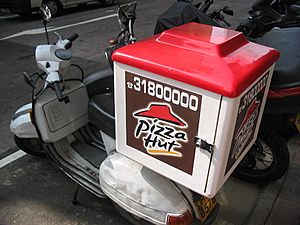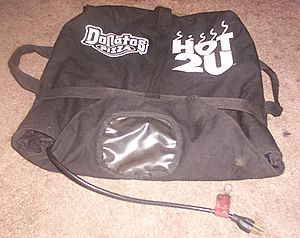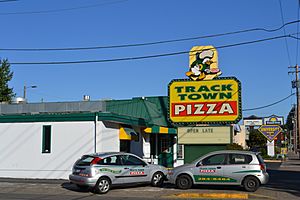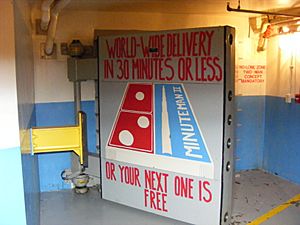Pizza delivery facts for kids
Pizza delivery is a service where a pizzeria (a pizza restaurant) or a pizza chain brings a pizza right to a customer's home or other location. People usually order pizza by calling the restaurant or by using the internet. When ordering, you can choose the type and size of pizza, and sometimes add other items like soft drinks. Pizzas are often delivered in special cardboard pizza boxes or insulated bags to keep them warm. Deliveries are made using cars, motorized scooters, or bicycles. Customers can pay online or in person with cash, credit card, or debit card. Sometimes there's a small delivery fee, but many places offer free delivery.
Contents
Ordering Your Pizza
Ordering pizza for delivery usually means getting in touch with a local pizza restaurant. Many pizza places now let you order online, where you can see their menu and choose what you want.
The pizza delivery business has changed a lot with new technology. Since the 1980s, computers have helped a lot. Special computer programs help delivery drivers find the fastest routes. They also help track exactly when an order is placed and delivered. Since 2008, GPS tracking has allowed customers to watch their delivery vehicle on the internet in real time!
Some pizzerias, like Pizza Pizza in Canada, used to promise to deliver within a certain time. For example, Domino's Pizza once had a famous promise in the 1980s: "30 minutes or it's free." This was stopped in the United States because hurried drivers sometimes had accidents. However, some countries still offer similar guarantees. If there's no time guarantee, the restaurant will usually tell you an estimated delivery time.
According to Domino's, some of the busiest days for pizza delivery are New Year's Eve, Super Bowl Sunday, Halloween, New Year's Day, and the day before Thanksgiving. Big events that aren't planned, like a major news event, can also make pizza deliveries go way up!
Delivery Charges and Tips
For many years, "free delivery" was a very popular saying for almost all pizza shops. In Australia, part of any delivery charge goes to the driver. This is because the store needs to pay the driver for using their own car.
Domino's Pizza helped make free pizza delivery popular in the United States. Later, some companies started adding a small delivery fee. For example, Pizza Hut began trying out a 50-cent delivery charge in 1999. By 2002, some stores from Domino's and Papa John's also started charging delivery fees, usually between 50 cents and $1.50.
In many countries, it's common to give the pizza deliverer an extra payment called a tip when you pay for your order. In Canada and the United States, tipping for pizza delivery is a common practice.
How Pizza Stays Hot: Delivery Technology
Special Delivery Bags
Bags used to keep pizza hot during delivery are often called hotbags. These are special thermal bags, usually made of strong materials like vinyl or nylon. They are designed to keep heat inside. Some hotbags even have electric heaters or special disks that warm up to keep the pizza extra hot. Newer bag designs for bike delivery are lighter and easier to carry.
The Pizza Box
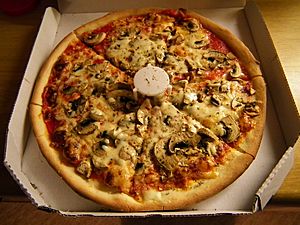
Today's pizza boxes are made from corrugated fiberboard. This material is great for pizza delivery because it's cheap, can be recycled, and is easy to throw away. It's also strong but light, and it soaks up oil and juice, stopping leaks. The air channels inside the cardboard are excellent at keeping the pizza warm.
The idea of a pizza box started in Naples, Italy, in the 1800s. Bakers used metal containers called stufas to carry pizzas. These were round, vented metal boxes with shelves. In the 1940s, people would take pizza home on a round cardboard base covered with a paper bag. It's believed that Domino's created the flat, square corrugated pizza box we know today in the early 1960s. They never patented it, but designs for pizza boxes have been patented since at least 1968.
Newer pizza boxes have special vents, built-in holders for sauces, and designs that make them easier to recycle. Some even have tops that can be torn into small plates! The lid of the box is often held up by a small plastic tripod, which is called a pizza saver.
Pizza boxes use a lot of cardboard. However, some recycling programs don't accept them because the cardboard often gets soaked with grease. This grease can make them hard to recycle. So, pizza boxes are often thrown away with regular trash. A more eco-friendly idea is to compost them. You can also tear off any clean, unstained parts of the box, like the lid or sides, and recycle those.
The Pizza Saver
In 1985, a woman named Carmela Vitale received a patent for a small plastic tripod stool. This little stool sits in the middle of the pizza box and stops the lid from sagging down and touching the pizza. Vitale called her invention a "package saver," but it's now famously known as the "pizza saver". Since then, other versions have been invented, like a plastic spatula that holds the lid up, or a tripod with one leg shaped like a knife to help cut stuck cheese.
Working as a Pizza Delivery Driver
In the United States, some groups have formed to help pizza delivery drivers. These groups, like the American Union of Pizza Delivery Drivers (AUPDD), work to improve working conditions and pay for drivers. Drivers sometimes face challenges, like low wages, and these groups aim to give them a stronger voice.
Safety for Delivery Drivers
Pizza delivery can sometimes be risky for drivers. They have to go to many different homes, sometimes in unfamiliar areas.
Some pizza companies have rules about drivers carrying weapons for safety. For example, some chains do not allow employees to carry weapons, even if it's legal. This is a topic that people have different opinions about.
Prank Orders
Pizza places can sometimes get fake orders for many pizzas, or orders sent to random houses. These prank orders can cost businesses money because they have to throw away the pizzas that aren't paid for. For example, in 2010, someone placed a prank order for 148 pizzas, costing nearly $4,000! In some places, like Singapore, people who make fake orders can be fined.
Dangers for Delivery Workers
Sadly, pizza delivery drivers have sometimes faced serious dangers, including robbery or other crimes while on the job. Sometimes, fake orders are used to trick drivers into dangerous situations. Delivery people have been hurt or even killed during these incidents.
Pizza Delivery in Movies and Books
Pizza delivery has been a big part of many stories in popular culture. In some books, the main character is a pizza delivery person. For example, in Neal Stephenson's book Snow Crash, pizza delivery is a huge business run by the Mafia in the future!
Several movies also feature pizza delivery. These include the 1984 comedy Delivery Boys, the 1989 film Do the Right Thing, and the 2000 comedy Dude, Where's My Car?. Sometimes, critics have felt that pizza delivery is used too much in movies, almost like an advertisement.
Pizza delivery has even been the main subject of films like Drivers Wanted and Fat Pizza: The Movie. The 2011 movie 30 Minutes or Less is about a kidnapped pizza delivery driver forced to rob a bank. On TV, the Australian comedy show Pizza is all about Pauly and his co-workers who deliver pizzas for a restaurant called Fat Pizza.
See also
 In Spanish: Pizza a domicilio para niños
In Spanish: Pizza a domicilio para niños


